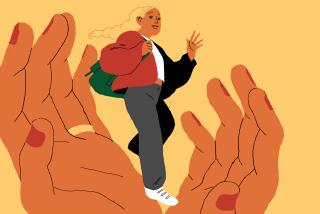Spinning Out a Dream and Dispelling a Curse
- Share via
Around the quadrangle of tables, a dozen young women are coaching each other, many talking simultaneously, about how to stay financially afoot on the unaccustomed landscape of adulthood.
“Don’t work at a place where you can buy stuff.”
“They’ll give you a check card, and you can swipe it anywhere. Don’t do it, girl!”
“Use coupons. They add up. Cut them things out.”
When Tiynesha Coleman begins to speak, the others fall silent. The gravity of her tone and the seriousness of her mien command attention.
“Don’t do something you can’t afford,” she warns. “I’m paying on three credit cards that are maxed out. I’m paying on a car, an apartment. I don’t have time for anything. All I do is work, work, work, and take care of my daughter. It’s lonely, and it’s hard.”
It would be difficult to assemble a group facing a more harrowing passage into adult life than these young women. Participants in the Los Angeles Florence Crittenton Center’s after-care program, they are in their late teens and early 20s. All “emancipated” at 18 from a childhood of multiple foster homes, many having ended their years as a minor living at the Crittenton center, a luckless girls’ home of last resort. Most already are mothers and alone. Emerging from the unsteadiest of childhoods, they commonly require instruction in everything from job interviewing to food shopping to having a normal conversation with a stranger. The young women are under a kind of curse laid by irresponsible parents and other adults. Dispelling it will require the sort of unstinting resolve rarely demanded of those whose upbringings were more blessed.
A case in point, Tiynesha Coleman. She is 22. At 6, she was taken from her drug-addled parents in West Covina. She was 12 and in her second foster home when her mother died of a heroin overdose. “They found her in an alley,” Tiynesha says.
As a teenager, she shied from social life, embarrassed by not living with her parents and having none of the fashionable possessions by which adolescents calibrate each other’s worth. She became attached to a boy of similar unmoorings.
She was 16 and in her third foster home when she found out she was pregnant with his child. Her condition required her to move to a fourth home. At 19, she graduated from John Muir High School in Pasadena and entered county-financed transitional housing with her daughter, Bridgette. A year later, her erstwhile boyfriend broke into the dwelling and beat Tiynesha up, drawing a prison term as a consequence.
Tiynesha completed, after high school, an eight-month course to become a medical assistant, and she took a full-time job, Monday through Friday, at a Covina doctor’s office. It pays $8.50 an hour. She got an additional job as a patient “sitter” at Huntington Memorial Hospital in Pasadena, working 7 a.m. to 7 p.m. Saturdays and Sundays. Her monthly income is $2,036. With a small, temporary rent subsidy from Crittenton for her two-bedroom apartment in Rowland Heights and a $40 monthly gasoline allowance, she makes ends meet.
Five-year-old Bridgette, meanwhile, shuttles between day care and Head Start and typically falls asleep at night alongside her mother. Tiynesha insists on evenings with her daughter, her 56-hour workweek notwithstanding (she hopes a recently completed nurse’s assistant course will soon enable her to make do with one better-paying job).
Of course, she has no time for a social life. “I never had a childhood and am not having a young adulthood,” she says. “I get depressed. I’d like to have a companion, but I’m not looking for anyone. I’m putting all my energy into Bridgette and into getting my education and getting on with my career. I have a picture cut out of the house I want someday, of the car I want. And I know what I want for my daughter--to send her to the best colleges, no matter what it costs. I want to travel with her to Europe on vacation, instead of just taking her to the park.”
To those ends, Tiynesha has a plan. In August she’ll begin preparatory courses for entering the licensed vocational nurse program at Citrus Community College in Glendora. “So, not later than February 2004, I should be working as an LVN.” Doing that 12 hours a day, five days a week, she estimates, she can earn plenty. “Then I’d have weekends with my daughter.”
She’ll cut her workweek to four days, however, when she enters Mt. San Antonio College in fall 2004, with plans to graduate as a registered nurse no later than 2006. After that, she’ll study for a bachelor’s degree at UCLA or USC or Cal State Dominguez Hills, which, she projects, will take an additional two or three years.
Then--tallest self-set obstacle of all--medical school. Getting her M.D. will require about 6 1/2 more years, according to her calculations.
“By the time I’m 35 or 40,” she says, “I should be OK.”
Tiynesha’s journey is bound to include barricades and detours she can’t currently envision, but it’s remarkable how the very misfortune that framed her young life seems to have given her a reliable sense of direction. She may prove an anomaly among the young women chattering around the Crittenton tables. I hope not. Wish them all well.
More to Read
Sign up for Essential California
The most important California stories and recommendations in your inbox every morning.
You may occasionally receive promotional content from the Los Angeles Times.










